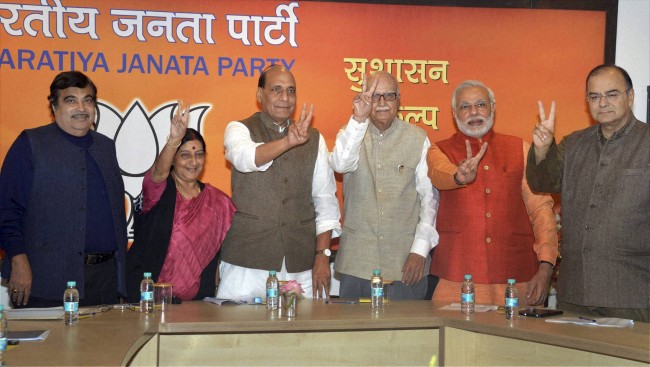In just a few hours, India’s national election results will be released.![]()
If exit polls (and virtually all polls, leading up to India’s six-week elections) are correct, Gujarat’s chief minister Narendra Modi will have delivered his conservative, Hindu nationalist Bharatiya Janata Party (the BJP, भारतीय जनता पार्टी) and its allies to a potentially historic victory — and an equally historic defeat for the ruling Indian National Congress (Congress, भारतीय राष्ट्रीय कांग्रेस).
Whatever happens when election results are announced, there’s no doubt that Modi led one of the most ‘presidential’ campaigns in Indian history. If the BJP emerges victorious, as expected, it will be a mandate for Modi as much as for the BJP.
The magic number is 272 — if the BJP-led National Democratic Alliance (NDA) can win an absolute majority in the Lok Sabha (लोक सभा), the lower house of the Indian parliament, Modi will certainly be India’s next prime minister, and he’ll likely steer a relatively stable government that should last for its full five-year term.
If the BJP and its allies fall short of 272 seats, while still emerging as the largest bloc in the Lok Sabha, they will also likely form the next government by forging a series of alliances with regional parties, including any of the following:
- the ruling, Dravidian AIADMK of Tamil Nadu’s chief minister Jayalalithaa;
- the Uttar Pradesh-based Bahujan Samaj Party (BSP) of former chief minister Mayawati; or
- the Biju Janata Dal (BJD), which is a former member of the NDA, and is forecast to win both state and Lok Sabha elections in the state of Odisha.
While regional allies might temper the Hindutva tendencies of a stronger BJP government, they might also prevent Modi from enacting the kind of economic reforms that he has promised to unleash greater GDP growth and development and to stymie bureaucratic waste and massive corruption.
In any event, almost every sign indicates that Modi will become India’s next prime minister, and he was already gathering with top BJP officials in Gujarat yesterday planning his new government (pictured below in a photo that Modi tweeted):
So who are the individuals that could become the most important officials in a Modi administration?
Here is Suffragio‘s guide to Modi-world — a list of 25 Indian politicians and leaders who are most expected to play a role in a government that promises to be very different than the current government.
The officials are divided into four categories:
- the BJP’s ‘old guard,’ which controlled the party in the its first major stint in government between 1998 and 2004;
- the BJP’s ‘new guard,’ the new generation of leadership with whom Modi is more comfortable;
- the Gujaratis, the members of Modi’s own inner circle after 13 years of state government; and
- the allies, those non-BJP party leaders who might be expected to take key roles within the NDA and otherwise in the next government.
Continue reading Who’s who in Modi-world: A guide to the next Indian government

